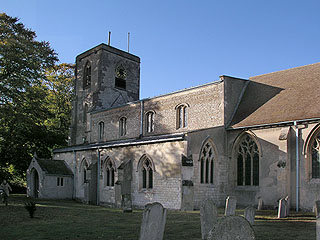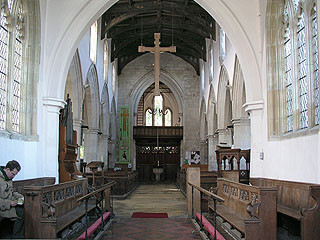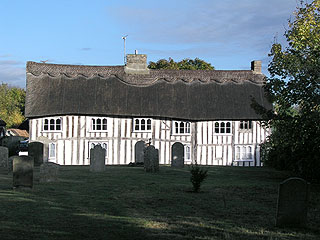St Mary's sits in a very open churchyard. The big chancel stands at the top of a steep bank leading down to the road - timber framed houses slump on the opposite side, staring up at it. The churchyard is bounded on the western side by quite a dense growth of beech trees, and the Early English west tower peeks coyly out from the branches. It was lovely when we arrived - the rain had just passed, so the houses were bathed in fine clear light, and the trees were full of bright jewels.
Most of the church is 14th century. The nave arcades have a certain heavy quality that I don't tend to associate with the period - Mark said he felt it looked rather monastic. The effect is relieved somewhat by the Perpendicular clerestory, which lights a very fine roof - we spotted the star of the De Vere Earls of Oxford on one boss. It would be easy to miss the roof, though, for there is much more interesting woodwork nearer the ground.
St Mary's has the best set of bench-ends I've yet seen in Cambridgeshire. The nave is full of them - and they all have animals instead of poppy-heads. It's quite a menagerie - my favourite was the leaping salmon at the back of the north aisle, but I also saw camels and mermaids as well as the more usual lions, wyverns and bulls. Some are quite badly mutilated, but it's still a splendid sight. [Mark adds: woodwork may have been a splendid defining feature of this church originally. When Dowsing came wrecking in the winter of 1643-4 he records that there were '4 crucifixes and Christ nayled to them, and God the Father on one of them' as well as '20 cherubims' - all destroyed]
Unlike the nave, the chancel is delicate and full of light. Pevsner identifies the nave as from the very early 14th century, and thinks that the chancel is from the second quarter - so, at most 50 years younger. The stylistic difference is enormous - I assume that the chancel was paid for by a particularly rich patron, but it's still a bit of a shock. The east window is filled with the sort of tracery I ought to describe as 'exuberant', and the other windows are scarcely less so. In the south wall there is a tomb recess with an elaborately moulded arch in the Perpendicular style. It dates from around the same time as when the clerestory was put on top of the nave; the sedilia and piscina are decorated in exactly the same style and form (with the tomb recess) a continuous panel of decorated alcoves all along the southern wall of the chancel.
It's similar to the sort of work one sees just up the road at Burwell, and I wouldn't be surprised if Swaffham Bulbeck hadn't decided to make use of that expertise, albeit on a much smaller scale. It's very nice, even if it looks a bit out of place in a Decorated chancel.
Finally, in the south aisle there is a very usual survival. It's a late 15th century Italian chest altar, originally made for travelling but now permanently settled here. It's quite battered on the outside, but the inside of the lid (which can be raised and used as a reredos) is beautifully carved with Biblical scenes - the Assumption, the Crucifixion and the Resurrection, all suffused with the rosy glow of old cedar wood. I wonder how it ended up here?
St Mary was open when we visited.


